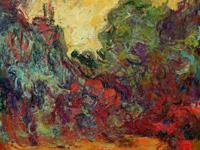Around the world, people think of one thing when they hear the name “Monet”: water lilies. Lots and lots of water lilies.
Claude Monet made more than 200 canvases featuring Nymphaeaceae, which are as closely linked to him as soup cans are to Andy Warhol and dripped paint to Jackson Pollock. Monet first exhibited his Water Lilies series in 1909, when he was almost 70 years old. The plants were his obsession in later age, as they grew in a pond on his estate in Giverny, France, which he staffed with gardeners who kept its waterway and gardens in idealized conditions. The new de Young exhibit, “Monet: The Late Years,” scrutinizes Monet’s final 13 years through his Giverny paintings, which means art-goers get to experience Monet’s big, last metamorphosis, when his lilies and trees became shrouded in abstraction just as Monet’s vision was also becoming more shrouded.
Cataracts threatened to eliminate Monet’s sight completely at the same time that he faced big emotional challenges. In his 70s, he was still mourning the deaths of his second wife, Alice, who died in 1911, and his son Jean, who died in 1914. And Monet was feeling the effects of World War I, which put the French military in battles practically at Monet’s doorstep. As art historian Charles Merrill Mount noted in his exhaustive 1966 biography, the painter was “filled with forebodings of his own end” but also “determinedly struck a defiant attitude.” Giverny and his new Water Lilies series were an escape and a “salvation” into something that Monet could actually control.
What they led to, the exhibit’s curators argue, was nothing less than the start of modern art. Purely abstract artists like Wassily Kandinsky and Ellsworth Kelly cited Monet as an inspiration, and the de Young’s exhibit plays up a quote from a 2015 interview that Kelly gave to Artspace, in which he said that Monet’s late work “changed me” upon seeing two of his paintings in Switzerland.
As it happens, one of the de Young exhibit’s most abstract works is on loan from Switzerland’s Kunstmuseum Basel. The Japanese Bridge, from 1919, is an almost amorphous forest of muted yellows and greens that hints at outlines and shapes. The actual Japanese bridge, which took people directly over Giverny’s pond, was a prominent subject for Monet, who — scores of times — painted the same scene in a much more delineated and colorful way. Monet’s most popular Water Lilies paintings, like the one at the de Young exhibit that’s usually displayed at the Legion of Honor (Water Lilies, 1914-1917), are saturated with beautiful, eye-popping blues and quasi-purples. The Kunstmuseum Basel’s The Japanese Bridge is transgressively understated. And it’s likely an example of Monet’s late output that art buyers — at least initially — ignored, shrugged at, or even sneered at. Many of these later paintings weren’t even exhibited until many years after Monet’s death in 1926.
“During his lifetime, no one [from the public] saw these paintings,” Marianne Mathieu, senior curator at Paris’ Musée Marmottan Monet, which loaned many of the exhibit’s works, said during last week’s press preview as she toured the exhibit’s second half. “We could call this exhibition ‘The hidden garden of Monet.’ ”
“There was no market for them — at all,” added George Shackelford, senior deputy director at the Kimbell Art Museum in Fort Worth and the organizer of “Monet: The Late Years,” which moves to the Kimbell this summer. “It was really only in the 1940s and ’50s that there came to be an appreciation for this late style in Monet’s art.”
The exhibit includes wall after wall of what could be termed Monet’s more conventional depictions of water lilies, and Monet’s late style produced works that eschewed dense abstraction. The exhibit’s last gallery features a series of canvases with the title Weeping Willow, from 1918-19, in which a single tree stands out amid branches and foliage that veer into interpretive assemblages of color and brush strokes. Even as he was losing his eyesight in later life, Monet never lost the physical stamina that he needed to hunker over his canvases and work them with swaths of paint and deep meaning. The willow tree itself may have been a metaphor for the challenged persistence that Monet needed to create his last decade of paintings. Visitors to “Monet: The Late Years” can — if they choose — relate to the works through this determinist stage of Monet’s life.
At the end of last week’s press preview, Melissa Buron, director of the Art Division at the Fine Arts Museums of San Francisco, said that a wheelchair-bound art-goer toured the exhibit a day earlier. This art-goer is terminally ill, and Monet is one of her favorite artists.
“One of the last adventures she wanted to have” was with Monet’s art, said Buron, who called the experience “a truly profound and humbling moment. …These works of art continue to speak to us in ways that we are still learning more about.”
Monet painted scenes of death in his lifetime, including his 1879 work, Camille on Her Death Bed, which depicts the passing of his first wife. But the end of World War I in 1918, when France and its allies (including the United States) defeated German forces, inspired Monet to move all-in with his Giverny paintings. He was already France’s most famous painter, a white-bearded figure whose estate became a pilgrimage site for aspiring artists around the world. As art-goers enter the de Young exhibit’s main gallery space, they see a silent black-and-white film of Monet at Giverny, painting a canvas as a cigarette dangles from his mouth. He’s wearing a white suit, and a white hat that was designed to focus his eyes. Save for a few other people in the film, Monet is alone with his canvas and his pond and his estate’s expansive nature. With the brief movie clips and the exhibit’s many photos and paintings, “It looks like we are in Giverny with him,” Mathieu said of the new exhibit.
But in one crucial way that’s a lie: “Monet: The Late Years” is almost guaranteed to be one of the de Young’s most successful exhibits, so hordes of people are expected to descend into the museum’s downstairs gallery. “Anything Impressionist, and anything Monet, just reeks of success,” Diane Wilsey, board president of the Fine Arts Museums of San Francisco, said earlier in the day. (Wilsey owns one of the works on display.)
So the challenge for art-goers at “Monet: The Late Years” will be to find the space and the sight lines to really see these paintings of such scope and stature — and to really be close to them the way Monet was at Giverny.
“Monet: The Late Years,” through May 27 at the de Young Museum, 50 Hagiwara Tea Garden Drive (Golden Gate Park). $20-$35, deyoung.famsf.org









